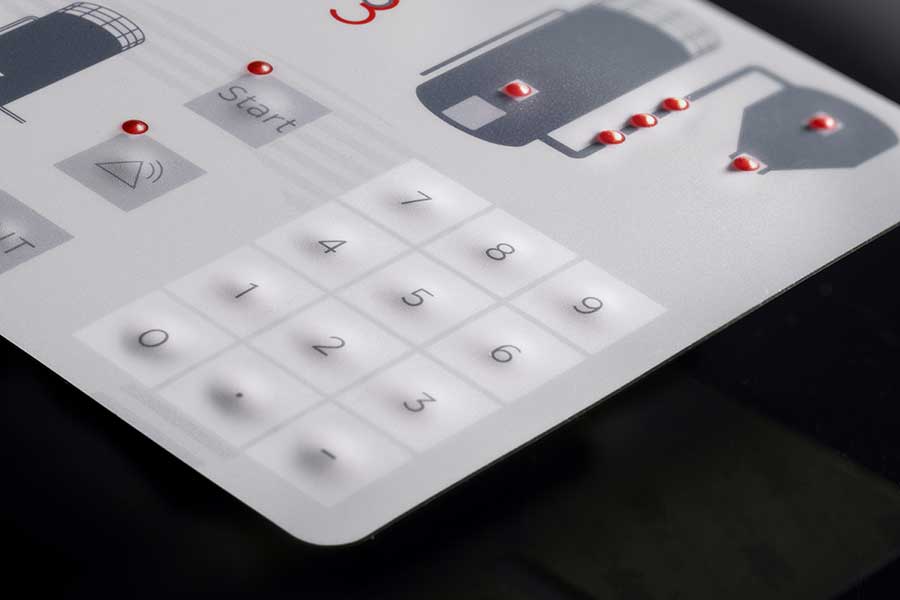Comprehending the Functionality of Membrane Changes for Interface Gadget
The performance of membrane changes represents a considerable advancement in customer interface style, incorporating efficiency with visual convenience. As industries significantly focus on individual experience, recognizing the subtleties of membrane button modern technology ends up being essential.
What Are Membrane Switches?
Membrane layer switches are innovative interface gadgets that facilitate user interaction with digital tools. These flexible parts contain numerous layers, including a graphic overlay, spacer, and a printed circuit layer. The style enables a smooth integration into numerous digital tools, improving both the aesthetic and functional elements of interface.
Membrane buttons are typically utilized in a large range of applications, from house devices to commercial machinery and clinical devices. Their building and construction typically features a slim account, making them a perfect choice for small layouts. The responsive comments supplied by these buttons can be crafted to satisfy details customer preferences, ensuring effective communication in between the user and the device.
Durability is another considerable advantage of membrane layer buttons, as they are immune to dirt, dampness, and chemicals, which improves their lifespan in demanding atmospheres. Furthermore, these buttons can be personalized in regards to form, dimension, and visuals layout, enabling branding and user-specific features. Overall, membrane layer switches over represent a functional service for boosting customer experience in electronic devices, incorporating functionality with aesthetic allure in an efficient fashion.
How Membrane Layer Changes Work
Operating on a straightforward concept, membrane layer changes use a layered construction to sign up individual input properly. Each button consists of several layers, consisting of a printed circuit layer, a spacer layer, and a leading graphic layer, which are made to collaborate perfectly. When an individual presses the top layer, it compresses the spacer layer, bringing the conductive components of the circuit layer right into contact with each other.
This get in touch with develops a closed circuit, indicating the device to carry out a particular feature. The style permits numerous arrangements, including responsive feedback, which can boost the customer experience by offering a physical feeling upon activation. The materials utilized in membrane layer switches frequently include flexible substratums, such as polyester or polycarbonate, which ensure longevity and strength against damage.

Trick Benefits of Membrane Switches

An additional considerable advantage is their density. Membrane layer buttons are slim and light-weight, which makes it possible for producers to save space in their devices without sacrificing functionality. This feature is particularly helpful in applications where weight and volume are critical considerations.
Furthermore, membrane layer buttons are immune to dirt, dampness, and chemicals, improving their longevity. This durability prolongs their lifespan and minimizes the need for regular replacements, basics causing expense savings over time.
Furthermore, the responsive feedback provided by membrane layer switches can be maximized to boost customer interaction. They can consist of functions such as raised buttons or distinct clicks, improving usability and individual experience.
Applications Throughout Industries
User interface devices making use of membrane buttons are common in a wide range of industries, showcasing their flexibility and performance. Membrane Switch. In the medical field, membrane layer switches are indispensable to gadgets such as analysis devices and client surveillance systems, where their resilience and ease of cleaning are crucial for maintaining hygiene requirements. In the automobile industry, these switches are used in control panel controls and infomercial systems, giving a sleek and modern-day user interface for customers.
Additionally, the consumer electronic devices sector advantages from membrane switches in home appliances and portable tools, where compact design and easy to use user interfaces enhance user experience. Industrial applications likewise take advantage of membrane layer switches for control panels in machinery and automation systems, stressing their effectiveness and resistance to extreme environments.
In the aerospace and protection sectors, membrane layer buttons are used in cabin controls and devices, where dependability and efficiency under severe problems are paramount. Furthermore, the gaming industry significantly includes membrane layer switches in controllers and arcade makers, contributing to an interesting individual experience. Overall, the versatility of membrane switches over allows their extensive usage across many sectors, underscoring their significance in contemporary user interface layout.
Future Trends in Membrane Layer Switch Over Modern Technology

Furthermore, using sophisticated products, such as polycarbonate and polyester movies, is anticipated to increase, providing enhanced Clicking Here toughness and resistance to environmental stress factors. These materials add to the general longevity of membrane layer switches, making them appropriate for harsher industrial applications.
Furthermore, the consolidation of smart innovation, consisting of IoT connectivity, will certainly make it possible for membrane layer buttons to communicate with various other tools and systems, assisting in a much more interactive user experience. This trend lines up with the growing demand for clever tools across numerous markets, from healthcare to customer electronics.
Finally, modification options are prepared for to increase, enabling makers to produce bespoke remedies tailored to particular user demands and choices. These advancements will certainly position membrane switches as vital parts in the evolution of user interface modern technology.
Conclusion
In final thought, membrane switches stand for an essential development in individual interface innovation, providing a reliable and functional remedy for click reference varied electronic applications. As developments in material scientific research and touch sensing innovations continue, the capability and applicability of membrane layer buttons are anticipated to increase, enhancing their relevance in modern-day digital devices.